
The COVID-19 pandemic will change the way vacation rental providers operate for the foreseeable future— cancellation policies, cleaning standards, procedures, and even the amenities and experiences you offer will be different. Rethinking how you market your properties will also change—from what you market to how and to whom. As you shift to a surgical focus on your drive-to market, this could be an audience who has been neglected by your traditional marketing for a while—those travelers desperate for ideas of where to go and what to do in their own neighborhood, so to speak.
Search terms for “vacations within 5 hours of [my location]” and “places to go near me” receive massive amounts of Google searches each month, and there is little doubt people are anxious to take a vacation close to home.
But how do you market to this audience? Luckily, with Google AdWords, Facebook and Instagram marketing, Pinterest advertising, and SEO, you can reach audiences looking for a vacation close to home.
Tips for Organic Marketing to Local Audiences
In my experience, organic (i.e., unpaid) marketing strategies are often overlooked or incomplete. Time, consistency, staffing, and knowledge are extremely important factors of the equation, and paying for advertising often seems easier. When you pay for advertising without focusing some of your efforts on organic marketing, however, you will always have to pay for advertising. Why not focus on just a few keys now that can lead to a big payoff in the long run?
Add Your Information—Everywhere
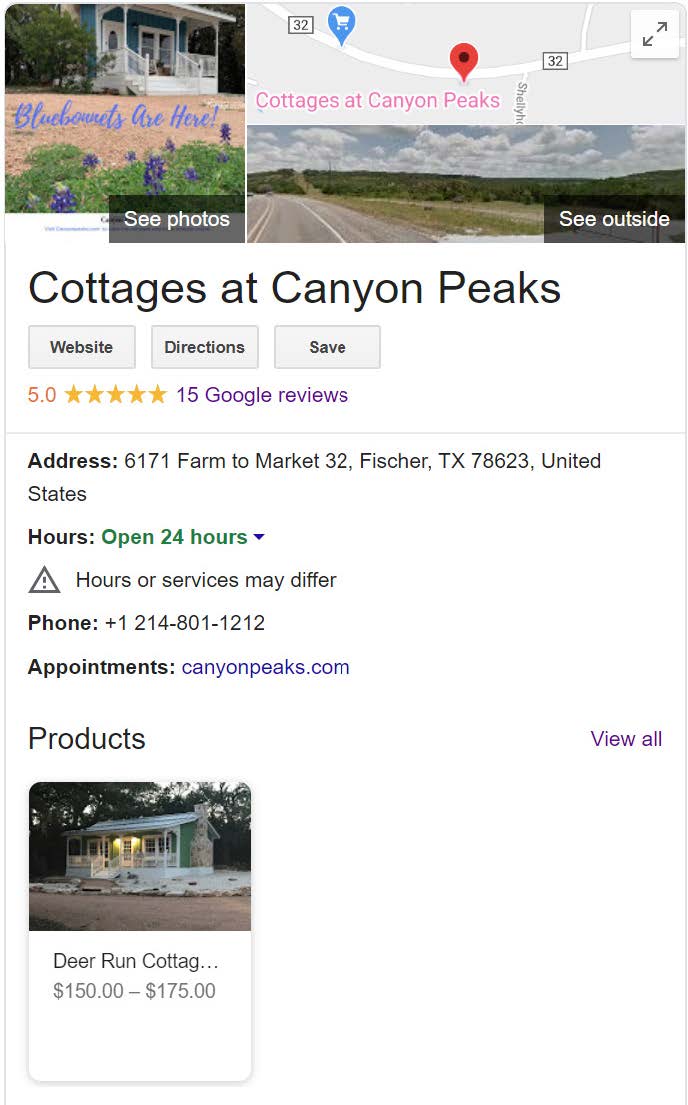 First, be sure you are in all the right places and that your information is consistent.
First, be sure you are in all the right places and that your information is consistent.
Set up Google Business to ensure your business shows up on Google Maps. Add your full address, your service areas (be broad), and a phone number with regional area code. Use keywords in your description that include distance from key cities within your six-hour drive radius; include regional terms such as “The Texas Hill Country” or “Florida Panhandle.” Once completed, set your business information up with the native iPhone map tool as well as with Bing business tools.
Then, add your info to Yellowpages.com, Yelp, Foursquare, Whitepages, and other local listing sites such as your local and regional chamber of commerce. Be sure all your information is consistent across every site. Your name, address, phone number, services, service areas, and details must all be the same for search engines to make the connection.
Don’t Neglect Local SEO
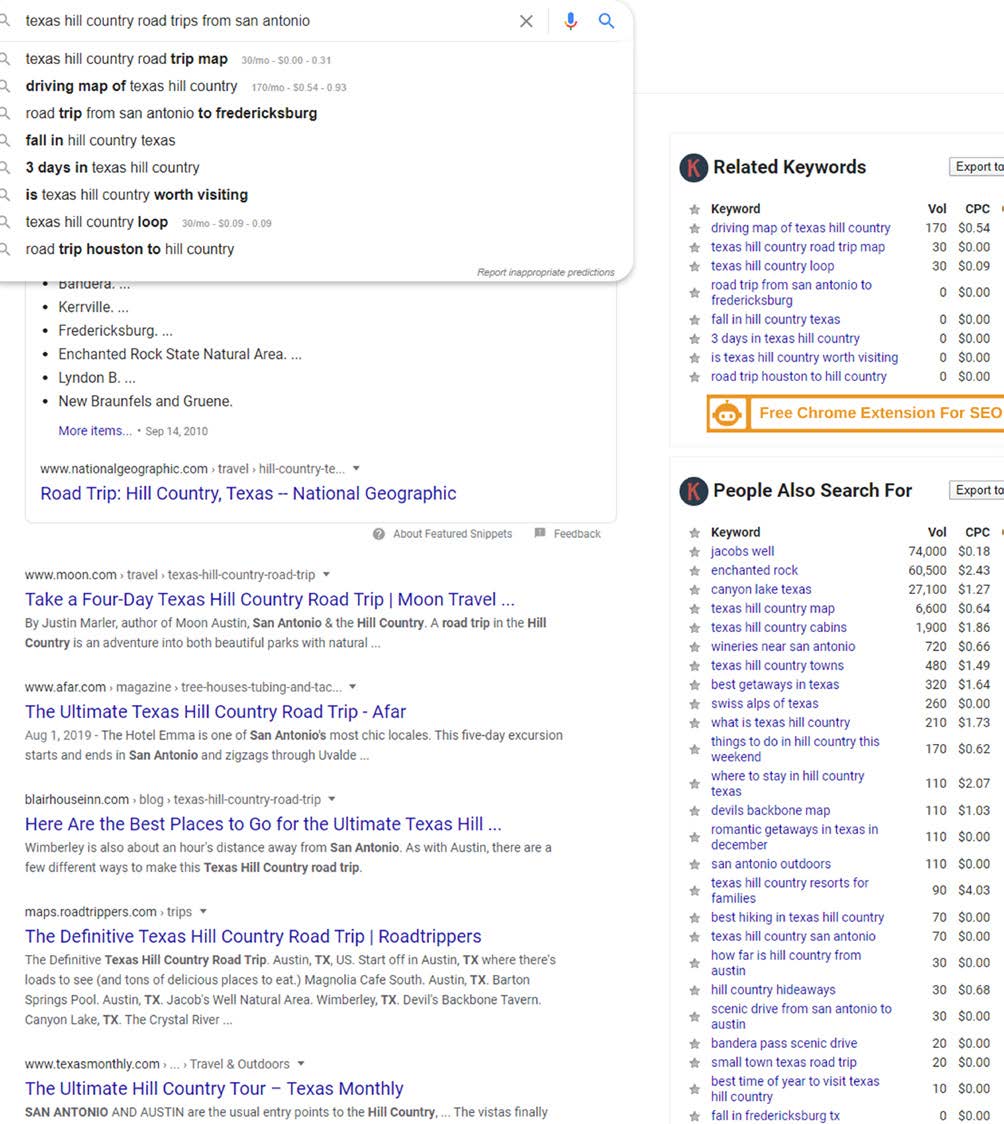 Looking at your website’s SEO, be sure your listing content, image tags, and meta descriptions include geographic location. Add your proximity to key cities and regions, such as “located two hours from Atlanta.”
Looking at your website’s SEO, be sure your listing content, image tags, and meta descriptions include geographic location. Add your proximity to key cities and regions, such as “located two hours from Atlanta.”
Add blog posts to your site as well—this is crucial for SEO. Focus on the keywords “weekend getaways near (large city or feeder zone)” or “things to do with kids in Central Florida.” Ensure your content includes location information, proximity details, and other necessary info.
Use a keyword tool such as Keywords Everywhere to find relevant topics.
Don’t try to rank your website for highly competitive content such as “things to do in San Antonio” with 74,000 monthly searches— find smaller, relevant searches such as “hill country road trip.” You can see from the image above a small inn has ranked fourth place for this term just by thoughtful use of keyword search and consistent, long-term blogging.
Use Social Media Marketing
It is crucial that your social media sites include all your relevant location and proximity details. Even if you do not use all these sites for marketing purposes, create your account and claim your business name; basic profile details, including “vacation rentals in Marathon, Florida Keys”; address; and phone number to Facebook, Instagram, Pinterest, Twitter, and LinkedIn.
Use Location Tags to Market Your Vacation Rental on Social Media
Another great idea is to create a Facebook location tag for your business and individual properties and ask guests to “check in” on Facebook and “tag” you on Instagram. Let guests know before their stay that you would love to share their photos on your profiles (many people love being featured on another social stream).
Pro Tip: To encourage your guests to check in, add a short request to your welcome note in the rental, or create a “special place” for photos at your property—maybe it’s a deck with a view or something even more original. One homeowner had a large wooden frame built with a gorgeous view behind it. She encouraged guests to take photos and share them on social media. Now, almost every guest makes use of this feature, and her Instagram stream is full of location tags.
Add location tags to your Instagram posts, stories, Facebook photos, and videos. Mix up your location tags often. You may want to share one post from a property’s exact address, the next post from your town, and then the next from the metro area.
How does this help with geotargeting? People who click that geotag location (or follow it) can view all the other posts people are uploading at that location. Those people will see the vacation rental photos and videos you have tagged—and those posts will reach a new audience. Travelers can search the geotags to decide if they want to book with you.
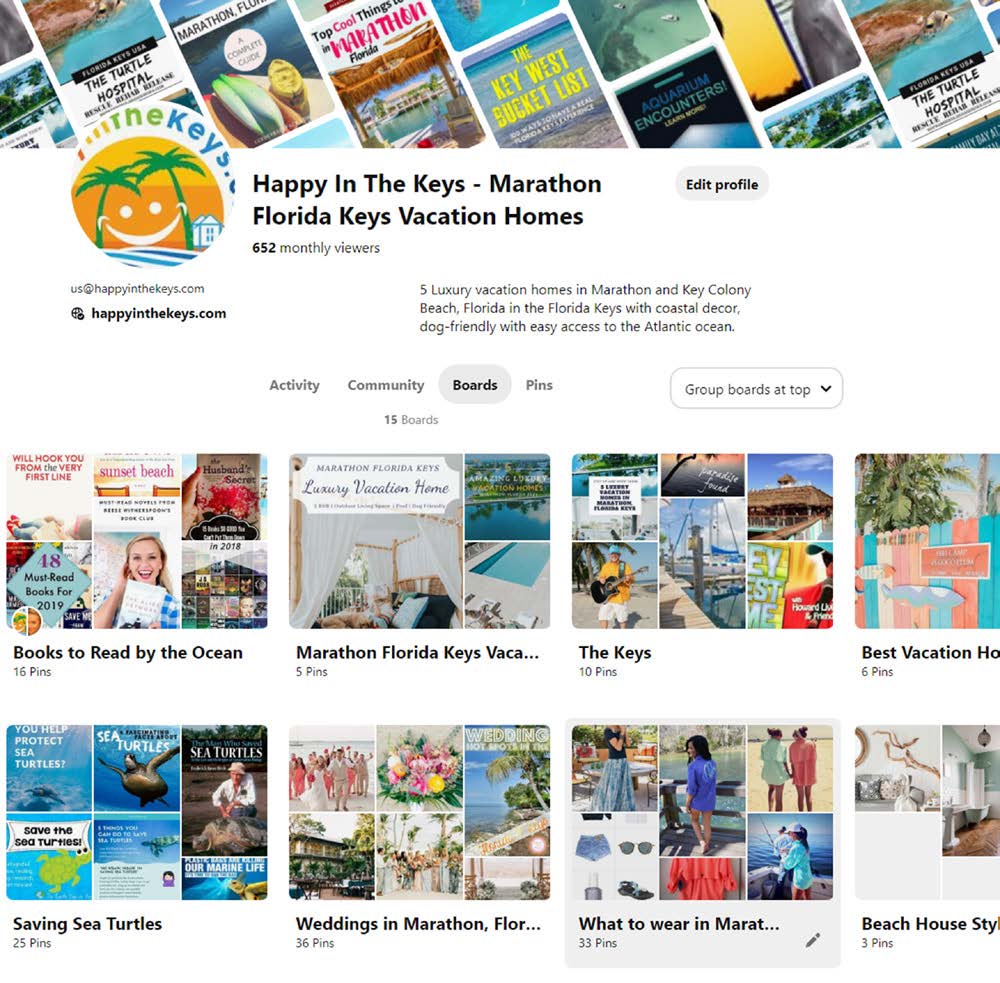 On Instagram and Pinterest, you can add location hashtags to your posts. People use hashtags to search for specific content. Think of it as a link to other related content. So, if you use the hashtag #bluemountainbeach or #30avacationrental in your posts, you increase your chances of being seen by people who search or follow those hashtags.
On Instagram and Pinterest, you can add location hashtags to your posts. People use hashtags to search for specific content. Think of it as a link to other related content. So, if you use the hashtag #bluemountainbeach or #30avacationrental in your posts, you increase your chances of being seen by people who search or follow those hashtags.
Although many people consider Pinterest a social media network, it is actually a top search engine, and location targeting on Pinterest is extremely helpful to your overall organic marketing strategy. In the example below, note the location-specific keywords used in the profile and on the Pinterest boards and pins.
When posting new content from your website to your Pinterest boards, include those relevant location keywords as well as your proximity keywords. “Vacation Rental Cabin in Marion, North Carolina, near Grandfather Mountain in the Blue Ridge Mountains. Our mountain cabin is a two-hour drive from Asheville, North Carolina, and five hours from Nashville.”
Look at how many location-specific keywords are included in one description field!
Pro Tip: Use old-fashioned public relations to get your vacation rental in front of a nearby audience. Do you have a fun experience awaiting travelers? Can you add relevant and newsworthy information to a media pitch to entice local travel bloggers or regional lifestyle magazines or newspapers? Your farm stay, glamping cottage, or historic rental may have the perfect story—don’t hesitate to share your pitch with large regional and city newspapers whose readers are looking for somewhere new to visit. These articles are extremely popular.
Geotargeting in Your Advertising
As you can see, adding your location in multiple places and in multiple ways across various sites can help improve your chances of being seen by audiences closer to your destination, but to guarantee more traffic to your website, consider geotargeted advertising as well.
Google Ads
Geotargeting in Google Ads is a fairly simple process. First, set up your ad information, including the landing page you are sending traffic to.
It is key that your ad copy and target location are specific and congruent to your landing page. People want to recognize themselves and their needs in your ad and web page. If your ad targets a large city, mention the city in the ad copy. If your ad mentions a winery tour or romantic getaway, include that in the ad copy as well as on the page to which you are sending traffic.
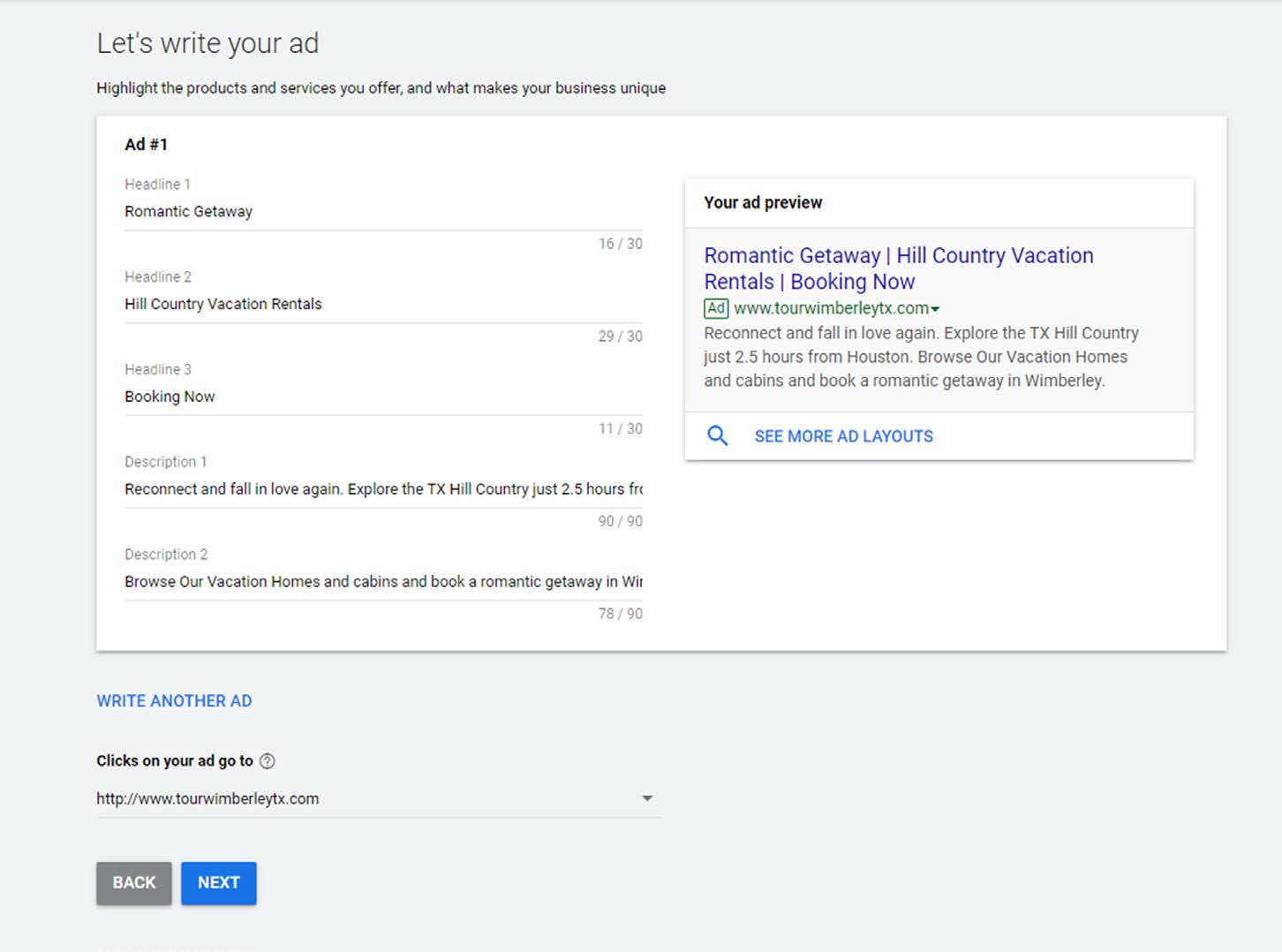 Next, limit your geographic search. In this ad (left), I’ll target Houston, Texas, so I will limit my ad geographic area to Houston and the surrounding suburbs. Fortunately, Google makes doing that a breeze.
Next, limit your geographic search. In this ad (left), I’ll target Houston, Texas, so I will limit my ad geographic area to Houston and the surrounding suburbs. Fortunately, Google makes doing that a breeze.
If I want to target a specific region but remove a particular geographic region, I can do that too. In this example, I am targeting the city of Austin and the surrounding area but have removed all zip codes within 40 miles of the vacation rental. This is just an example—for the most part, you’ll want to exclude a larger radius around your destination.
Next, limit your geographic search. In this ad (bottom left), I’ll target Houston, 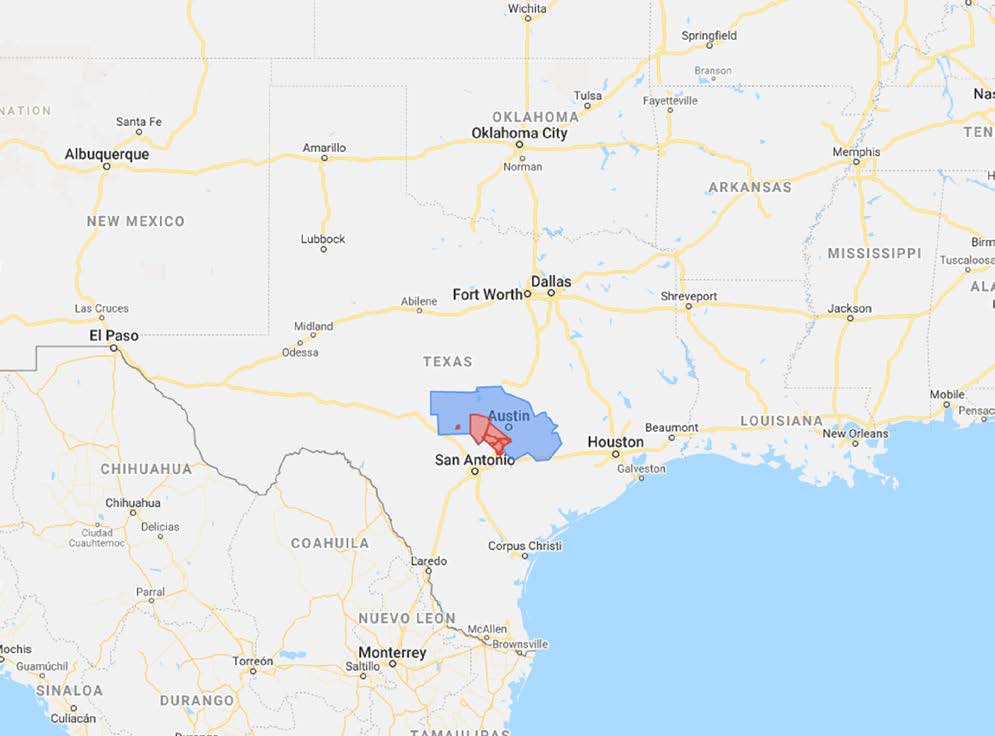 Texas, so I will limit my ad geographic area to Houston and the surrounding suburbs. Fortunately, Google makes doing that a breeze.
Texas, so I will limit my ad geographic area to Houston and the surrounding suburbs. Fortunately, Google makes doing that a breeze.
If I want to target a specific region but remove a particular geographic region, I can do that too. In this example, I am targeting the city of Austin and the surrounding area but have removed all zip codes within 40 miles of the vacation rental. This is just an example—for the most part, you’ll want to exclude a larger radius around your destination.
Try a variety of copy, depending on the keywords and locations you are targeting. Think of who is searching for the terms you are targeting. Are you talking to busy moms looking for an inexpensive family vacation? If so, say that in your ad.
Facebook and Instagram Advertising
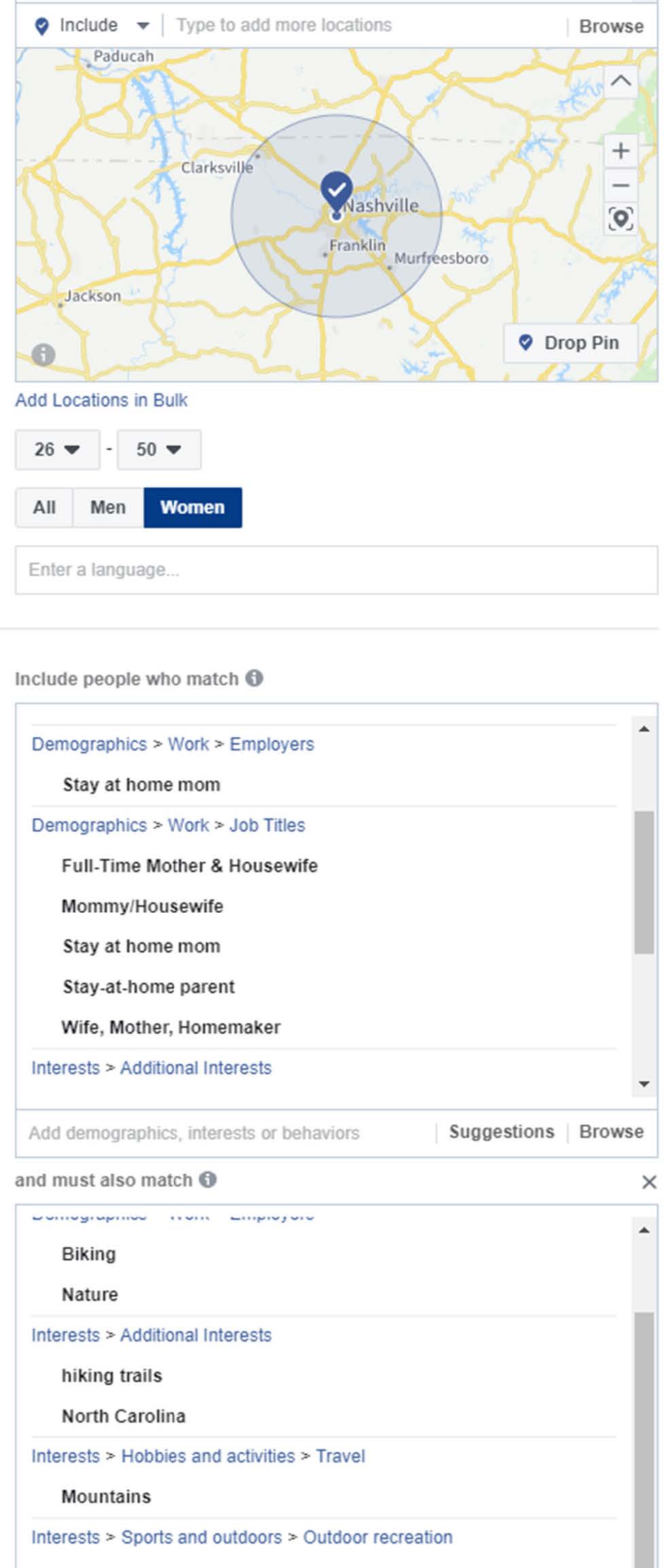 Facebook and Instagram ads are similar to Google Ads in that you can target specific geographic regions; however, these are interruptive ads, so rather than targeting keywords people are searching for, target audiences by interest and demographics and then limit that audience by geographic region.
Facebook and Instagram ads are similar to Google Ads in that you can target specific geographic regions; however, these are interruptive ads, so rather than targeting keywords people are searching for, target audiences by interest and demographics and then limit that audience by geographic region.
I love these ads for vacation rentals for several reasons. First, people love great photos and videos of destinations, so it is easy to get their attention if you have good imagery.
A strategic process is definitely involved in connecting your ad, your audience, and your imagery, so pay careful attention to those details. For example, if you are targeting parents of toddlers and school-aged children, then you want congruency.
First, create a great video, slideshow, or still image showing children happily riding their bikes on a trail, swimming in a pool, roasting marshmallows, or building a sandcastle.
Next, be sure your ad copy relates to the vacation experience for the kids and the mom. Speak directly to her: “Moms, are you ready to get your kids off the computer and out in nature? Plan a family hiking trip to the mountains—just a five-hour drive from Nashville. Visit our mountain cabin, and spend your days hiking, biking, and playing in the trees and your evenings roasting marshmallows.”
Third, set up your Facebook audience in Facebook Ads Manager. Choose demographics, behaviors, and interests such as women aged 30 to 45; parents of toddlers and preteens; and people interested in hiking, camping, and so forth. Don’t forget to target your specific city or region (the five-hour drive radius is great).
I encourage you to be creative with the ad copy, images, and videos you use in your Facebook and Instagram ads. With interruptive marketing (interrupting the user with something they may not be searching for), stand out in the newsfeed to entice the user to spend time with your ad, watch your video, read your copy, and ultimately click on your landing page.
Pro Tip: Set up multiple campaigns at once. Determine your budget, choose a few different audiences (including retargeting your website visitors), and create compelling content that speaks to the specific niches you are targeting.
Combined Advertising for a Winning Strategy
One of my favorite strategies of late is to create geotargeted Pinterest ads that send people back to website content that is not a booking call to action. Using Pinterest keyword research, determine content you can create for your site, such as “10 great breweries to visit in North Carolina.”
In your article, lead the reader with links to your booking page with gentle calls to action.
Pinterest ads are relatively inexpensive, so create a few different images or videos for the content and add your creative pins to a couple of different Pinterest boards. Then set up advertising for the pin using keywords and geotargeting.
In the meantime, create a Facebook audience based on your Facebook pixels for your blog post page—that page only.
You can set up a Google AdWords ad for the same content. Then, let your Pinterest ad “seed” your Facebook pixel. This means your website traffic will increase from your Pinterest ad.
You can then remarket to that traffic in Facebook ads only to only those people who saw your content. You can now be even more specific with them, and they may be ready to see your message about your vacation rental within a few miles of those 10 great breweries.
This effort definitely takes some planning, but this kind of campaign can create multiple audiences for future use. Add an email signup form to your blog page, set up new “lookalike” audiences, send the post to your current email list, and pursue many other options.
It’s all part of a feeder-market strategy—and in these trying times, a strategy is what you may need to survive and thrive.




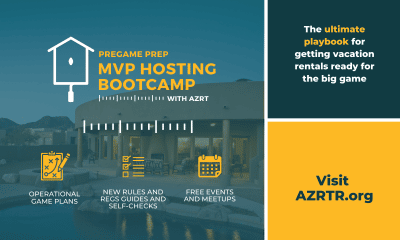







RSS